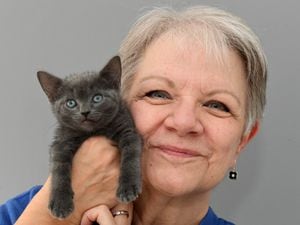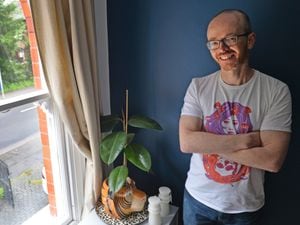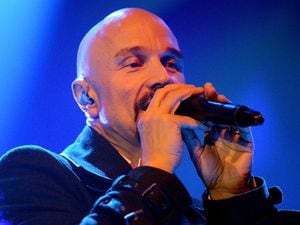From the Black Country to Bogota: On the trail of the drug lords
Waves ripple and then break on to the muddy banks of the San Juan river as our speedboat cuts up the deep and dark waterway.
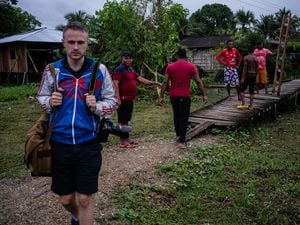
It’s late morning. Fishermen bring in their catches and the laughter of children can be heard from a collection of tin-roofed buildings on shore.
This river, right in the heart of the Colombian rainforest, feels at peace.
But there’s a dark secret.
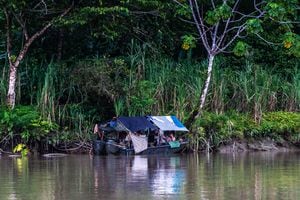
Two military boat hidden under overhanging trees on the riverbank offer the first clue – an army checkpoint.
For this 240-mile river is one of the busiest drug trafficking corridors in Colombia.
The product is cocaine.
The stretch of river marks the start of a 5,000-mile odyssey to the streets of the Black Country, Staffordshire and Shropshire.
It’s a journey fraught with environmental destruction, exploitation and violence which often ends with an undignified snort.
“Everyone knows what’s coming down the river, it’s a drug which is feeding a growing demand around the world,” says Father Alberto Franco, a leader of the Inter-Church Justice and Peace Commission.
“People turn a blind eye to it, but it’s causing big problems for everyone.”
The drugs helped fund a 50-year civil war between the Revolutionary Armed Forces of Colombia (FARC) and the Government which left 220,000 people dead.
Almost 80,000 people are still missing.
A peace accord signed two years ago brought hope.
But it has only left areas of the country wide open for more armed groups, including paramilitaries and the National Liberation Army (ELN), an insurgent group.
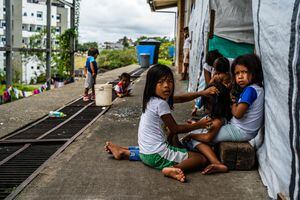
The result is a power struggle over land which results in a deadly game of massacres, threat of violence and mass displacement of people.
The losers are the innocent farming communities.
“They turned up . . . armed men and walked into our community,” says Fabiola Quintero, one of around 20 women who gather to meet us at the riverside village of Santa Rosa de Guayacan.
The tribe perform a ceremonial welcome. Half-naked, they form a circle and clap their hands as they sing quietly.
This indigenous community has lived here for generations, but their existence is under threat from armed groups fighting for control of the vital waterway.
The 23-year-old says: “I was bathing in the river and I saw a boat coming towards me, the men jumped out and started coming toward our village.
“I went to the village and they followed me up the hill.
“The men were all out working and it was just women and children left. I was so scared and frightened.
“They said they were doing nothing, then after a while they got back in their boat and left.”
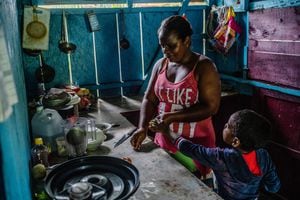
She adds: “We don’t want these people here.”
Such acts of intimidation are just one way armed groups remind communities of their presence, their power.
But it is such acts which can lead to violence and death.
A rival armed group could take ‘revenge’, seeing the visit as a sign of the community siding with one side.
It is why the community has established an internationally protected ‘humanitarian zone’. A zone where armed units are banned and in which no contact to armed groups is allowed.
Ten miles down the river in Cabeceras, another community is creating a similar zone, backed by Christian Aid, as well as the Inter-Church Justice and Peace Commission.Inside a schoolhouse a large banner is rolled out and the 30-strong community all hold it before Father Franco gives a blessing which members pray will be a turning point in their lives.
Tears are shed as victims of killings and displacement are remembered, before the banner is placed overlooking the river.
Among those there is Siode Arboleda, aged 35, whose two brothers were murdered in a massacre in a neighbouring village called Carrá in March last year.
The men, Elcias and Dider Arboleda had dropped their wives off at a women’s day and were collecting petrol in their boat when they were approached from behind by a group of armed men who opened fire.
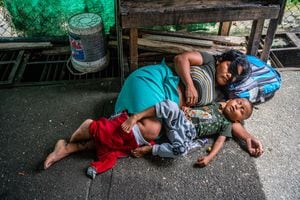
A 14-year-old boy escaped with a bullet wound to his arm and the community all fled – 52 people – to a nearby town.
A flag with a ELN emblem was placed among the dead bodies on the river bank. Yet, it could have been a set-up and an investigation into the deaths was inconclusive.
Human Rights Watch filed a report on the killing, stating the ELN had a year earlier come to the village, accusing leaders of cooperating with the rival paramilitary group Gaitanist Self-Defenses of Colombia (AGC) group.
It’s another example of the confusion, misery faced by communities along the riverbank who are in constant fear of their lives.
“We know that all the different actors are moving around on the river and there is combat between them to control this region, so that they can move their product, says Dagoberto Pretel, a legal representative for the villages.
“If there weren’t drug traffickers, we would live like we did 15 or 20 years ago. We would live in peace,” he adds.
Unlike at Santa Rosa De Guayacan, this is a Afro-Colombian community, and just like the neighbouring village, this one has previously been displaced, only returning to their homes in March.
The decision to leave in April last year came following two instances of fighting between armed groups close to the village, the final one was the last straw.
“We woke up to hear loud machine gun fire,” says Mr Pretel.
“There were helicopters overhead and we later saw six black bags pulled up from the river.
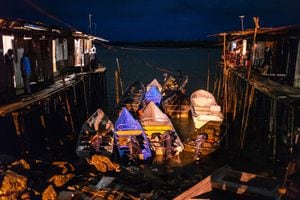
“We had people fishing in the river, it was a miracle they survived.”
The community of more than 1,000 people abandoned their homes and moved to Buenaventura where they stayed next to the city’s sports arena in cramped conditions.
Mr Pretel says: “We were told that if we came back our lives would be at risk – but we are farmers and our home is here.
“Hopefully with the strength of support we have received, we can remain, but we are still very scared.”
John Mosquera, aged 31, discovered the murdered bodies from the massacre in Carrá, which happened just a week after the fighting in Cabeceras. He attended the banner unveiling to show his support.
Yet people from his village are still too terrified to return to their homes.
“I saw the bodies and stuck between them was an ELN flag,” he says.
“There is a new paramilitary group in the area. Maybe they wanted to send a message to people not to join that group. Maybe they wanted to warn us? I don’t know.”
Mrs Arboleda still mourns her brothers. She says: “It hurts me so much. I’ve lost my brothers, for what?”
It is a question on the minds of all innocent groups along the river. Like diamonds in Sierra Leone and gold in South Africa, when quantities of rich natural resources are discovered, it often brings with it conflict.
In Colombia it’s the coca leaf.
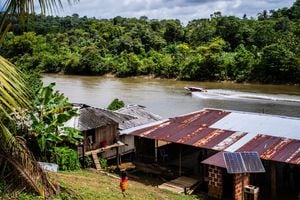
As demand for the party drug around the world increases, so does the need for land to grow the leaves and for laboratories to produce the drug.
A UN report published last month revealed 171,000 hectares is used to grow coca leaves in Colombia. The highest number since records began. And in 2016, 850 tonnes of cocaine were produced.
Despite farmers getting only a slither of the profits to be made from the drug, it still makes more than the alternatives – plantain, bananas and avocado.
Christian Aid and the Government attempt to promote the farming of other products.
But it can be a losing battle.
“We never grew coca leaves but since we have been forced to leave our lands we know it is happening [on our lands] now,” says Ernesto Chililiano, who fled to Buenaventura with his community of Wounan people two years ago.
The group left after an army bombing raid on an ELN camp took place close to their community.
Members now live in cramped conditions at a former school in the city.
Mr Chililiano says: “It is all about acquiring power of land for cultivation of the leaves.
“It creates conflict which then leads to violence and the displacement of communities like us.
“We just want to go home.”
The anguish and pain suffered by those displaced is literally thousands of miles away from the brief high enjoyed by those in the Black Country and Staffordshire.
According to the Office for National Statistics, 1.7 per cent of people in the West Midlands used the drug over the past year. But evidence suggests this figure is not correct.
The average price of a gram in the UK is £41, according to the UN’s World Drug Report, but prices can go up to £200.
Pivaza Opua, also part of the displaced Wounan community, says: “To the far-away communities I would say ‘be careful, lives are worth more than a few hundred dollars.
“The drug only brings bad things’.”
Pictures by Federico Rios
COKE SMUGGLED IN BANANA SHIPMENTS
Cocaine is not usually associated with bananas – but gangs are using shipments of the fruit to get the drugs to North America and Europe.
Incidents have even occurred where supermarket workers have opened packages to find millions of pounds worth of the substance. It’s the most common way of getting the drugs from the illegal laboratories to the streets of the West Midlands and Shropshire.
The journey is one of corruption, intimidation and violence, says Father Alberto Franco, a leader of the Inter-Church Justice and Peace Commission.
He knows the route well having worked on the drug trafficking corridor of the river San Juan and in seaport Buenaventura for more than 35 years.
“Everyone knows it is going on, but because of the fear of violence there is little people can do.” he says.
It starts in the coca plant fields where the leaves are picked and then taken to a laboratory nearby for production.
It’s then loaded on mules to the rivers San Juan and Naya before the produce is put on to boats, bound for the sea port of Buenaventura.
Army checkpoints already know the boats are coming down and turn a blind eye to the passing boats, says Father Franco.
“There have been situations when a boat clearly being used by local people has been pulled over while an armed boat is allowed to go on by,” he says.
At Buenaventura the drugs are placed on to big ships, concealed within legal shipments such as bananas.
From there, it can take many routes.
One is to central America and then Africa where it can be transported over land or air to the UK.
Another is to off-land Spain where the shipments are loaded on to a smaller boat which takes it to Europe.
“London, Paris, Berlin – that’s where the drugs go on from there.”
Once in London, cocaine can take many routes up to the West Midlands.
With the emergence of County Lines, drug dealing networks targeting rural towns, the drug has become more readily available.
The National Crime Agency, in its National Strategic Assessment of Serious and Organised Crime, says: “Demand for all common drug types remains high in the UK.
“Profits are high at all stages of drug trafficking but maximised for those with upstream access.
“Increased production and supply has reduced the need for suppliers to adulterate.
“Consequently, cocaine purity at street level remains high.”
FACTS – Cocaine production in Colombia
2017 - 1,379 tonnes / 16 - 1,053 tonnes
Land used for cocaine production – 2017 -171,000 hectacres / 2016 - 146,000 hectacres
Cocaine seizures – 2017 - 435,431kg / 2016 - 362,415kg
Illegal laboratories destroyed – 2017 - 4,252 / 2016 - 4,820
Drug trafficking offences in UK in 2016/17 – 26,585 offences, down 11 per cent from last year


